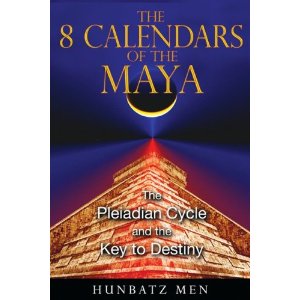|
The Synchronized
Calendars of the Mayan People*
An
Excerpt from
The 8
Calendars of the Maya**
by
Hunbatz
Men
Tzek'eb or
Pleiades Calendar
The group of stars currently known as the Pleiades or Seven Sisters was, in
the time of the Mayans, known as Tzek'eb and was symbolically represented by
the seven rattles of the serpent. Since the beginning of their existence,
the Mayan people viewed the Pleiades as their axis of life on Earth and
consequently included these stars in their calendars; they also included the
number seven in their culture in a pervasive and profound manner. The seven
stars of the Pleiades were very important for the Mayans because, according
to their beliefs, life began on planet Earth at the same time that these
stars first settled in their place in the sky.
The scientist Otto Hesse tells us that the Pleiades, located in the
constellation of Taurus, are centered around Alcyone, a giant star with a
brilliance 1,400 times that of the sun. Further, Hesse claims that our solar
system is actually part of the system of the Pleiades, and that the sun
occupies the seventh orbit in this System. Significantly, once again, the
number seven is present in this relationship between our solar system and
the Pleiades. Hesse states that our solar system revolves around Alcyone
every 26,000 years and also that our solar energy is influenced by Alcyone,
which is at the center of the Pleiades. These facts Hesse mentions were very
well known to the Mayans, as is demonstrated by their astronomical
calendars.
According to my investigations, the Tzek'eb Calendar began on March 21
of the year 3373 BCE, when our Mayan ancestors saw the great sun of the
solar system of Maia above the horizon of our sun. It is worth noting that
in the Mayan tradition, our Father Sun had seven brothers; together we all
form a single great cosmic family. Since the Pleiades are composed of seven
principal stars, or suns, the Mayans deduced that each of these suns
deposited its energetic power in us when we human beings were formed,
meaning that we in fact possess the power of these suns. We each have these
seven powers of our solar family within our bodies. In fact, all
manifestations of life include this seven energy.
Alcyone (center)
1. Merope
2. Maia
3. Electra
4. Taygeta
5. Celaeno
6. Atlas
7. Our Solar System
The Pleiades or Tzek'eb Star System. Our solar system revolves around
Alcyone, along with a number of other suns; in this manner, we are part of
the Pleiades. Our solar system occupies the seventh orbit around the
Pleiades, known as Tzek'eb in the Mayan language.
Representing the principle of life on planet Earth, the Pleiades became
the cultural axis of the ancient Mayan people. Their religion and
mathematics, as well as their physical bodies, were intimately connected
with the seven stars or suns of the Pleiades. All of the Mayan mathematical
and astronomical calendars were closely connected to the Pleiades. Though
the Mayans had many calendars, behind them all was the calendar of the Great
Year of 26,000 years, the time our sun takes to complete a single revolution
around Alcyone, with all the planets accompanying it. This Great Year is
also known as Tzek'eb in the Mayan language.
There were abundant reasons for the Mayans to call themselves Children
of the Sun; as we have seen, they were well aware of solar laws. The Tzek'eb
Calendar was a cosmic calendar of the suns, established by the great Mayan
astronomical sages and used to keep track of the great solar cycles, 26,000
years in duration. For the Mayans, each sun has a cycle of 26,000 years. And
according to the Mayans, when the end of a solar cycle is reached, great
changes occur in our planet Earth, and very probably in our entire solar
system. We are currently in the fifth sun, according to our cosmic Tzek'eb
Calendar, which tells us that Four suns, or four 26,000-year solar cycles,
have already passed. This means that 104,000 years have passed according to
the Mayan cosmic calendar.
Tzek'eb and the Pyramid of
Kukulcan
The Pyramid of Kukulcan in Chichén Itzá, Yucatán, Mexico, has a close
relationship to the Pleiades or Seven Sisters and therefore to the Tzek'eb
Calendar. Fifty-two great marks can be seen on each of the four sides of
this pyramid. This number, fifty-two, is related to the Tunben K'ak'
Calendar, translated as "New Fire." The indigenous peoples of the Americas
celebrated the cycle of this calendar every fifty-two years, since fifty-two
years represented a complete lesser cycle of the Pleiades or Tzek'eb.
Every year, on March 21 and September 21, at the equinoxes, seven
markings were seen, produced by the light and darkness of the Pyramid of
Kukulcan as the sun began to set in the west. This phenomenon took place on
the north side of the pyramid; seven triangles appeared on the side of the
steps that were used for climbing the edifice. We know that these
Mesoamerican peoples performed great rituals at the equinoxes, when the
seven isosceles triangles appeared on the Pyramid of Kukulcan. But the most
important rituals were celebrated every fifty-two years.
The ancient Itza Mayans built the pyramid at Chichén Itzá in order to
observe the movements of the planets and other celestial bodies. They made
it in order that they might be continually aware of the planetary movements;
Chichén Itzá, Mexico, was the center of this learning. The Chilam Balam and
the Hauk'in were the astronomers who were responsible for this scientific
place. All that they observed was used to educate the public; thus the Mayan
people were taught the secrets that the scientists were discovering, secrets
that were recorded in writing in the Mayan codices.
* Excerpted with permission of the publisher,
Bear & Company. Copyright c 2010 Hunbatz Men. All Rights Reserved
** To order this book from Amazon.com, click
here! |
